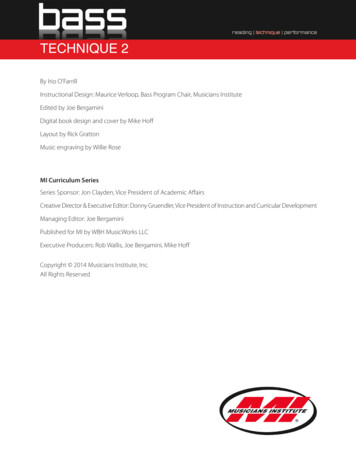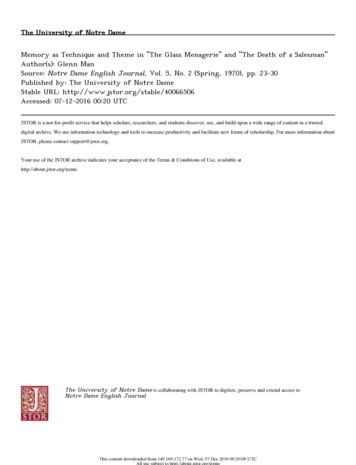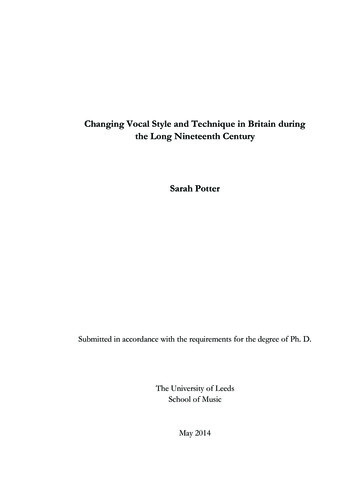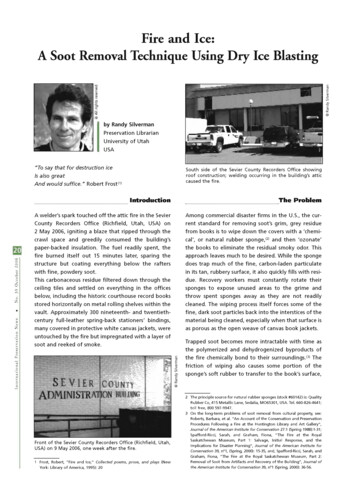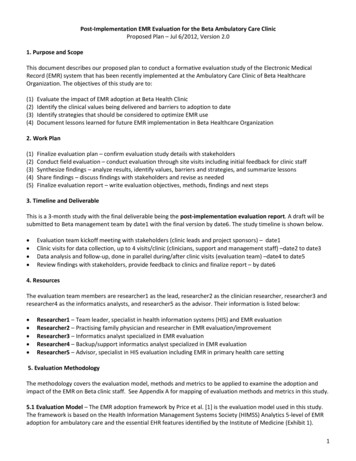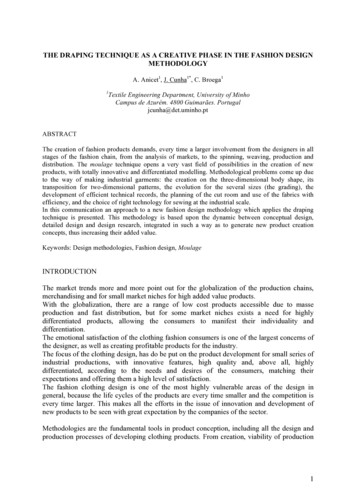
Transcription
7ANALYZING THE AUTHOR’SPURPOSE AND TECHNIQUEThe writer’s overall purpose determines the techniques he or she uses. The writer’sreason for writing a particular article or book may be manipulative, as in propagandaor advertising, or may be more straightforward, as in informative writing. In eithercase, understanding the writer’s underlying purpose will help you interpret the context of thewriting. It will also help you see why writers make the decisions they do—from the largestdecisions about what information to present to the smallest details of what words to use. Thechapter concludes with instructions on how to write an analysis of purpose and technique. Thiskind of rhetorical analysis will provide the perspective required to keep you from being pushed bywords in directions you don’t want to go.103
104Part 1Writing About ReadingThe Writer's PurposeInsofar as people know what they are doing, they plan their actions to achieve their purposes.Someone who selects the purpose of being rich will design and carry out a set of actions, legal orillegal, to gain the desired wealth. A person who wants to gain great wisdom will design anentirely different life course. Writers, whether they want most to be wealthy or wise, have specificpurposes they hope to achieve by any piece of work. If they are skilled writers—that is, in controlof what they write—they design each aspect of what they are writing to achieve their purpose.Being aware of the writer's purpose when you read helps you evaluate how well the writer hasachieved the purpose and decide whether you want to follow where the writer is trying to leadyou. The active reader reads more than the words and more than even the ideas: the active readerreads what the writer is doing. The active reader reconstructs the overall design, both the writer'spurpose and the techniques used to realize that purpose.In this chapter, we initially consider the various purposes a writer may have and the ways inwhich a reader can discern that purpose. Next we discuss the various techniques available towriters and in a case study look at several examples of how technique is related to purpose. Thechapter ends with specific instructions on how to write an essay analyzing purpose andtechnique.The Ad Writer's PurposeLiving as we do in a consumerist and merchandising society, we are all sensitive to thedesigns of advertising. We know the purpose of most advertisements is to get us to open up ourwallets and surrender their contents willingly and even enthusiastically. We are alsointellectually aware of most of the techniques that advertisers use to entice us: emotionallycharged language, vivid art, attractive models, appeals to our fantasies and our fears.Nike, a manufacturer of athletic shoes and sportswear, for example, has used ad campaignson television and in print media to encourage us to buy the newest, most high-tech, mostfashionable sneakers on the market. How can advertising make us purchase an eighty-dollar pairof high-top basketball shoes when we don't even play basketball? By making us feel we needthem. Advertising tries to convince us that wearing Nike products will make us happy people. Theadvertising would have us associate positive emotions springing from health and physical fitnesswith Nike products and feel guilty for being lazy, eating junk food, and talking about turning overa new leaf tomorrow.One particular Nike advertising campaign, built around the slogan “JUST DO IT,” attempts tochallenge us to get off the sofa, put down the television remote control, and exerciseregularly-and then to associate our feelings of accomplishment and pride with Nike athleticshoes. The slogan suggests that readers will be exchanging bad habits for good ones when theybuy a new pair of shoes. Of course, readers must do something to accomplish all this: in order to“just do it” (stop being lazy and start exercising), they first have to buy a pair of Nikes. The sloganalso implies (perhaps legitimately) that consumers have something to gain (at the very least, afashionable new pair of shoes; at the most, better health) and nothing to lose (not exactlytrue—the shoes are costly).The two-page spread originally appeared in a weekly magazine targeting African Americans inthe business world. Like most of Nike's print ads, this one targets a specific audience: educated,professional African-American males. By repeating the “JUST DO IT” slogan while challengingpotential consumers to achieve in every facet of experience, the company is insisting that wearingNike shoes is a sign of success not just on the basketball Court, but in the game of life. The visual
Chapter 7Analyzing the Author's Purpose and Techniqueimpact of the ad is created by the contrast between light and dark in a wide-angle photograph ofa dimly lit alley. The only light appears in the distant figure dressed in a white sweat suit,shooting hoops on an outdoor basketball court; in the white lettering of the printed copy runningdown the right side of the right-hand page; and in the Nike logo in the top left corner of theleft-hand page. The lone athlete, the white lettering, and the Nike logo stand out and “rise above”an obscure environment—challenging the potential consumer to do likewise. The narrative itselfreinforces and clarifies the message. The first seven lines list the nicknames of athletes whosucceeded in sports but not in life, because they didn't know they had “all the tools.” The twelfthline, “Fortunately, you do,” contrasts these men with the reader directly. The rest of the narrativechallenges him to use the tools available to excel in all aspects of life: “Go back to school. Start abusiness. Coach little league. Vote. JUST DO IT.” The reader could bike to work, get his bloodpressure checked, visit Africa, and run for public office without wearing Nike athletic shoes, butthe fact that Nike is issuing the challenges—emphasized by repetition of the Nikeslogan—suggests that the company cares about much more than physical fitness. This adunderplays its “Buy shoes” message and instead subtly invites the reader to associate positiveimages and ideas with the company that produces the shoes. The ad's final two lines restate thecontrasts presented in the visual and narrative elements and emphasize the seriousness of themanufacturer's message: “Remember. It's a must win situation.”Since this advertisement in the Nike campaign appeals to both the desires and the fears of itstarget audience, it does not need to provide a direct sell. Instead, through vivid visual imageryand evocative language, the designers of the ad attempt to equate a product withself-improvement and overall success. Neither the word shoe nor a close-up photograph of theproduct appears in the ad. The company name and logo appear only once, in small letters in onecorner; neither appears in the printed copy of the ad. Because of the number and frequency ofads in the campaign, most potential consumers know what this particular ad is about.Emphasizing the product or the company is unnecessary; the “JUST DO IT” slogan is synonymous with the company name; and just about everyone knows what Nike produces.Federal regulations outlaw advertising claims that are outright deceptions; and someadvertisements are designed to be merely informative, to just let us know that a product withspecific features is available on the market. Even Nike has designed ads with this intent: forexample, the series of ads promoting the “Air Jordan” basketball shoe, with a pump, claimed toprovide adequate arch support and decrease impact stress. Nonetheless, even the plainestadvertisements emphasize certain of the consumers' needs and attitudes at the expense ofothers. Most advertisements try to distract us from a simple, rational consideration of what weneed and what we actually receive in return when we purchase particular products. Even thetechniques of amusement—if we laugh at the advertisement, we will remember the product andbuy it—lead us away from analyzing the value we receive in exchange for our money.FOR CLASS DISCUSSIONDiscuss how the copywriters and art directors of the two advertisements on pages 195-196have created both text and art that they think will make consumers want to respond in certainways. What group of people does each advertisement address, and how does each appeal to itsparticular audience? Do the ads have features that would appeal to consumers of a particularrace, sex, or age group? How is each advertisement designed to generate a particular action fromits designated readership? How well do you feel each fulfills its purpose? How do the differencesin audience and purpose account for differences in the presentation of each advertisement? Findother magazine or newspaper advertisements for discussion.105
106Part 1Writing About ReadingThe Propagandist's PurposePropaganda, like advertising, aims to make us forget reason. Propaganda may serve tofurther political ambitions, to drum up support for questionable governmental policies, or toconfuse political discussions by deflecting attention from the real issues.In the early 1950s, Senator Joseph McCarthy relied heavily on propaganda to advance hisown career and to create extreme anti-Communist fear and hysteria. In the following excerptfrom a speech he delivered in the Senate on July 6, 1950, McCarthy turns his apparent supportof President Harry S Truman's decision to send United States troops to Korea into an attack onsupposed Communist sympathizers in Washington.Mr. President, at this very moment GIs are consecrating the hills and the valleys of Koreawith American blood. But all that blood is not staining the Korean hills and valleys. Some of itis deeply and permanently staining the hands of Washington politicians.Some men of little minds and less morals are today using the Korean war as a profitablepolitical diversion, a vehicle by which to build up battered reputations because ofincompetence and worse. The American people have long condemned war profiteerswho promptly crowd the landscape the moment their Nation is at war. Today, Mr. President,war profiteers of a new and infinitely more debased type are cluttering the landscape inWashington. They are political war profiteers. Today they are going all-out in an effort to sellthe American people the idea that in order to successfully fight communism abroad, wemust give Communists and traitors at home complete unmolested freedom of action. Theyare hiding behind the word “unity,” using it without meaning, but as a mere catch phrase tocenter the attention of the American people solely on the fighting front. They argue that ifwe expose Communists, fellow travelers, and traitors in our Government, that somehow thiswill injure our war effort. Actually, anyone who can add two and two must realize that if ourwar effort is to be successful, we must redouble our efforts to get rid of those who, eitherbecause of incompetence or because of loyalty to the Communist philosophy, have laidthe groundwork and paved the way for disaster.The pattern will become clearer as the casualty lists mount. Anyone who criticizes themurderous incompetence of those who are responsible for this disaster, anyone who placesthe finger upon dupes and traitors in Washington, because of whose acts young men arealready dying, will be guilty of creating disunity.Already this cry has reached fantastic pinnacles of moronic thinking. Take, for example,the local Daily Worker, that is, the Washington Post. The other day this newspaper ran aneditorial in effect accusing the University of California of injuring the war effort bydischarging 137 teachers and other employees who refused to certify that they were notmembers of the Communist International conspiracy. This, Mr. President, would be laughable if it came merely from the Communist Party's mouthpiece, the New York Daily Worker,and its mockingbirds like the Washington Post. Unfortunately, a few of the Nation'srespectable but misguided writers are being sold this same bill of goods, namely, that tohave unity in our military effort the truth about Communists at home must be suppressed.McCarthy begins by flag waving; that is, by playing on strong national feeling. By praisingAmerican soldiers, he makes himself appear patriotic with only the interests of his country atheart. He also arouses in his listeners patriotic feeling in support of the self-sacrificing GIs. But inthe second sentence, he turns this patriotic feeling against Washington politicians. McCarthystarts name calling, which he continues throughout the speech. With no detailed evidence orother support, he labels certain unidentified members of the government as incompetents,Communists, dupes, and traitors. He repeats these labels throughout his attack, but he neverbecomes specific about who these traitors are, what their exact crimes are, and what his evidenceis. Thus he makes only blanket accusations that cannot be pinpointed and therefore cannot beproved or disproved.
Chapter 7Analyzing the Author's Purpose and TechniqueGuilt by Association As part of his labeling, McCarthy employs guilt by association: heassociates members of the government with war profiteers who had been the object of publichatred for many years. Similarly, he associates the Washington Post, an independent newspaper,with the Daily Worker, the official newspaper of the Communist party.Finally, the whole excerpt relies on scapegoating, putting the blame on those who are nottruly responsible. If American soldiers are dying and if casualty lists are mounting, McCarthywants to make it appear that the fault belongs to our government officials andnewspapers—especially those that McCarthy does not like. Rather than saying it is the NorthKorean army killing our soldiers, McCarthy puts bloodstains on “the hands of Washingtonpoliticians.”Unfortunately, propaganda is sometimes very effective, particularly at times of crisis whenemotions run high. Playing on the Korean War and Soviet expansion in Eastern Europe,McCarthy temporarily gained substantial power and created a climate of terror in this country, aclimate that took many years to dispel.Campaign SpeechesNot all propaganda strategies are as obvious as those McCarthy used. In fact, mostpropaganda is much more subtle and difficult to detect, and this is particularly true ofpropaganda used during elections. The 1992 presidential campaign was no exception. In anunusual three-way race, all the candidates—the incumbent, President George Bush; theDemocratic challenger, Bill Clinton; and the independent candidate, Ross Perot—relied onpropaganda to court potential voters. Following are the candidates' closing statements from thesecond of three presidential debates televised during the month before the election. Notice how inhis closing statement, each candidate uses a variety of propaganda strategies to appeal to theelectorate.Closing StatementsBUSH. Let me just say to the American people in, in two and a half weeks we're going tochoose who should sit in this Oval Office. Who to lead the economic recovery, who to bethe leader of the free world, who to get the deficit down.Three ways to do that: One is to raise taxes; one is to reduce spending, controlling thatmandatory spending; another one is to invest and save and to stimulate growth.I do not want to raise taxes. I differ with the two here on that. I'm just not going to do that. Ido believe that we need to control mandatory spending. I think we need to invest andsave more. I believe that we need to educate better and retrain better. I believe that weneed to export more, so I'll keep working for export agreements where we can sell moreabroad. And I believe that we must strengthen the family. We've got to strengthen thefamily.Now let me pose this question to America: If in the next five minutes, a television announcercame on and said there is a major international crisis—there is a major threat to the world orin this country-a major threat. My question is: Who, if you were appointed to name one ofthe three of us, who would you choose? Who has the perseverance, the character, theintegrity, the maturity to get the job done? I hope I'm that person. Thank you very, verymuch.Q. Thank you, Mr. President. And now, a closing statement from Mr. Perot.PEROT. If the American people want to do it and not talk about it, then, they ought-youknow, I'm not person they ought to consider. If they just want to keep slow-dancing and talkabout it, and not do it, I'm not your man. I am results-oriented, I am action-oriented. I've builtmy businesses. Getting things done in three months what my competitors took 18 months to107
108Part 1Writing About Readingdo. Everybody says you can't do that in Congress; sure you can do that with Congress.Congress is—they're all good people. They're all patriots. But you've got to link arms andwork with them. Sure, you'll have arguments; sure, you'll have fights. We have them all day,every day. But we get the job done.I have to come back in my close to one thing, because I am passionate about education. Iwas talking about early childhood education for disadvantaged low-income children. Andlet me tell you one specific pilot program, where children who don't have, chance go tothis program when they're three and now we're going back to when the mother's pregnant.They'll start right after they're born. But going-starting when they're three and going to thisschool until they're nine, and then going into the public schools in the fourth grade? Ninetypercent are on the honor roll. Now, that will change America. Those children will all go tocollege. They will live the American dream.And I beg the American people, any time they think about reforming education, to takethis piece of society that doesn't have a chance and take these little pieces of clay thatcan be shaped and molded and give them the same love and nurture and affection andsupport you give your children, and teach them that they are unique and that they'reprecious and there's only one person in the world like them and you will see this nationbloom. And we will have so many people who are qualified for the top job that it will beterrific and finally, if you can't pay the bill, you're dead in the water. And we have got to putour nation back to work. If you don't want to really do that, I'm not your man. I'd go crazysitting up there slow-dancing that one; in other words unless we're going to do it, then picksomebody who likes to talk about it. Now just remember, when you think about me, I didn'tcreate this mess, I've been paying taxes like you. And Lord knows, I've paid my share. Overa billion dollars in taxes. For a guy that started out with everything he owns in—Q. I'm sorry.PEROT. It's in your hands. I wish you well. I'll see you tomorrow night. On NBC 10:30, 11Eastern.Q. And finally, last but not least, Governor Clinton.CLINTON. Thank you, Carole. Thank you ladies and gentlemen. Since I suggested this forumand I hope it's been good for all of you, I've really tried to be faithful to your request that weanswer the questions specifically and pointedly. I thought I owed that to you and I respectyou for being here and for the impact you've had on making this a more positive experience.These problems are not easy and not going to be solved overnight. But I want you to thinkabout just two or three things. First of all the people of my state have let me be theGovernor for 12 years because I made commitments to two things. More jobs and betterschools. Our schools are now better: our children get off to a better start from preschoolprograms and smaller classes in the early grades, and we have one of the most aggressiveadult education programs in the country. We talked about that. This year my state ranks firstin the country in job growth, fourth in manufacturing job growth, fourth in income growth,fourth in the decline of poverty. I'm proud of that. It happened because I could work withpeople, Republicans and Democrats. That's why we've had twenty-four retired generalsand admirals, hundreds of business people, many of them Republican, support thiscampaign.You have to decide whether you want to change or not. We do not need four more yearsof an economic theory that doesn't work. We've had twelve years of trickle-downeconomics. It's time to put the American people first, to invest and grow this economy. I'mthe only person here who's ever balanced the government budget and I've presentedtwelve of them and cut spending repeatedly, but you cannot just get there by balancingthe budget. We've got to grow the economy by putting people first. Real people like you.I've got into this race because I did not want my child to grow up to be part of the firstgeneration of Americans to do worse than their parents. We're better than that. We can dobetter than that. I want to make America as great as it can be and I ask for your help indoing it. Thank you very much.
Chapter 7Analyzing the Author's Purpose and TechniqueBush begins by stroking his audience and attempting to stack the cards in his own favor. Atthe beginning of his statement, he sandwiches his strongest point—his foreign policyleadership—between the two “big issues” for which he has been criticized: the economy and thebudget deficit. He then uses glittering generalities—as to the need to “strengthen the family” andthe importance of “character,” “integrity,” and “maturity”—to cause his audience to associate hiscandidacy with positive emotions. Finally, Bush plays on his audience's fears when he asks thevoters who their choice would be if in the next five minutes, the nation were faced with a majorinternational threat.Perot, as the underdog, strokes his audience much more directly. He underplays his ownaccomplishments and flatters his audience by repeatedly stating that the voters are important:“It's in your hands.” He uses plain-folks appeal by reminding his audience that he's just like them(and therefore not like the other two candidates). “I've been paying taxes,” Perot states, “like you,”and he has been using plain, folksy language—“If they just want to keep slow-dancing and talkabout it, and not do it, I'm not your man.” Like Bush, Perot uses glittering generalities toassociate his candidacy with what his audience holds dear: children and “the American dream.”Clinton, like Bush, engages in some subtle cardstacking. Emphasizing the positive andignoring the negative, he points to his record as governor of Arkansas, cites statistics to lendauthenticity to these claims, and mentions the range of people who endorse him. At the sametime, like Perot, he strokes his audience by promising to put “real people” like them first. And heplays on voters' guilt when he suggests that voting for Bush or Perot will be an act of selfishnessthat the voters' children will ultimately pay for.Straightforward PurposesWhen advertisers or propagandists try to manipulate our opinions and actions, we maybecome suspicious about the truthfulness of their statements. Fortunately, only a small fractionof writing is deliberately manipulative. More often a writer's purposes are honest, and thetechniques writers use are not aimed at distorting readers' judgment. A novelist may wish toamuse us. A reporter may wish to inform us as objectively as possible. A political commentatormay want us to think seriously about a matter of public concern. Still, we should know writers'purposes, not to guard ourselves-as we do against propaganda and misleading advertising—butto understand the legitimate uses we can make of writers' statements.If you are not aware of the general theme of a book, you may be misled about its meaning.Perhaps when you stop by the local bookstore, you pick up a paperback and start reading in themiddle:Mario stood in the doorway, a strange light flashing from his eyes. His lips barely moved,“Carmen, I am here.”“But Mario, I thought,.” her voice quivered.“No. There was one thing I had to do first.” His deliberate steps matched the pounding ofher heart. His eyes, flashing fire, fixed on her. He stopped in front of her, his lips slightlyopened as if he had something to say, but couldn't say it. He reached for her.True passion? You love romances and are about to buy it. But wait. You turn to the cover.Compelled to Murder. You do not enjoy thrillers so you replace it on the rack. The overall design ofa piece of writing helps define the purpose and technique of each small part: the same words thatbring expectation and a melting heart in a romantic fantasy bring fear and dread in a murdermystery.109
110Part 1Writing About ReadingThe message that words convey depends on the purpose of the words within the context of alarger communication. For example, when the following words appear in a dictionary, they simplyprovide a definition, one piece of information among many other similar pieces of information.[COPYRIGHTED MATERIAL REMOVED]The dictionary tells you that affective is one word in the English language with a specific spellingand meaning, used particularly in the field of psychology. If, however, that same definitionappears with a dozen other terms on a ditto sheet handed out by your psychology professor onthe first day of class, the message is that you had better learn that word, for it is part of the basicvocabulary for the course. If your English professor writes the definition in the margin of yourpaper-after circling the word you wrote and changing your a to an e—the message is that youconfused affective with the more common word effective. In each of these instances, yourknowledge of the larger context helps you see the purpose of the text and receive the message itswriter intended.A Catalogue of the Purposes of WritingThe list of some of the more common purposes of writing that follows may help you identifythe purposes of pieces of writing you read. Whenever you read a piece of writing, ask yourselfwhat its purpose is and whether it fits in any of these categories. For example, the list of stockmarket prices in this morning's newspaper clearly belongs in the category “the conduct ofbusiness” and in the subcategory “to report information needed for making new decisions.” Aneditorial in the same paper might be considered “instigation of public thought and action,”specifically “to criticize the actions” of a particular public official. The comic strips would be“entertainment,” perhaps in any of the three subcategories. Textbooks, including this one, are forthe “transmission of knowledge to a wider audience” either “to provide an introduction to an areaof knowledge” or “to instruct rigorously.”As you try to categorize actual pieces of writing that you have read, you may find that onepiece of writing may serve several purposes; an amusing parody of a political candidate aims toinfluence your vote even as it entertains you. You may also find that you need to add categories orsubcategories to fit the special text you are examining.EntertainmentTo amuse and to delightTo arouse emotions and sympathiesTo appeal to fantasy and imaginationInstigation of Public Thought and ActionTo raise questionsTo criticize the actions of others; to reprimandTo weaken the support of opponentsTo persuade to act, vote, donate, etc.To inform of issues of concern
Chapter 7Analyzing the Author's Purpose and TechniqueThe Support of a Community of Common BeliefsTo state one's beliefs; to take a standTo repeat the accepted beliefs of a group; to encourage and reinforce these beliefso share recent developments and events that are of mutual concernTo gain tolerance for one's beliefs in the wider communityTo persuade others of the correctness of certain views; to gain approvalTo recruit active support; to proselytizeThe Conduct of Business and GovernmentTo promulgate laws, regulations, guidelinesTo report information needed for making new decisions, laws, policiesTo argue for certain lines of actionTo request funds or propose an activity to be fundedTo keep track of funds, projects, activities; to report on accomplishments and failures; to evaluateactivitiesTo sell, advertiseTransmission of Knowledge to a Wider AudienceTo satisfy curiosityTo provide practical information for everyday useTo provide an introduction to an area of knowledgeTo instruct rigorously, passing on the most recent knowledge, skill, or techniqueScholarly InquiryTo present new findings, recent information, the results of experimentsTo present new interpretations, speculations, thoughtsTo gather together all that is currently known on a subject to see how it fits together and to reach someconclusionsTo show the relationship of two areas of study and to show the light one sheds on the otherTo determine the truth of a matter and to prove that truth to other researchersClues to the Author's PurposeWe cannot read the minds of authors to find out what their true purposes are, but externallyavailable clues reveal much about their purposes.Overt Statements Pieces of writing that begin or end with commands like “vote for Paulsen” or“donate to this worthy cause today” make no secret of the writer's intentions. Titles can clearlyindicate purpose, such as How to Be a Big Winner on the Stock Market, The Encyclopedia ofSports, A Report on the Status of Mine Inspection Procedures, The Case for National HealthInsurance, and Spanish Self-Taught. Often in scholarly or professional books, and sometimes inmore popular works, the introduction or preface specifically states the author's purpose andoutlines the issues that gave rise to the book.111
112Part 1Writing About ReadingKnowledge About Publication Even if the author does not state the purpose of a piece ofwriting directly, where an article is published reveals much. An article appearing in aprofessional journal like Journal of the History of Ideas, Harvard Theological Review, or Journal ofGeology is most likely to present new information or research and to evaluate current kn
reason for writing a particular article or book may be manipulative, as in propaganda or advertising, or may be more straightforward, as in informative writing. . vivid art, attractive models, appeals to our fantasies and our fears. . war profiteers of a new and inf
